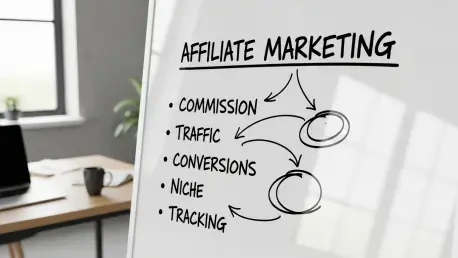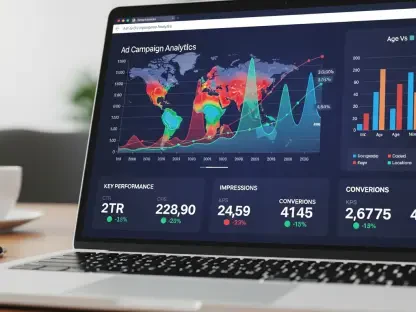Imagine an affiliate marketer hitting a significant milestone by driving thousands of dollars in revenue through a personal loan campaign, only to realize that the earnings stop the moment the leads convert. This scenario underscores a critical decision point in affiliate marketing: whether to chase quick, one-time payouts or build a stream of ongoing income. In the dynamic landscape of 2025, choosing between Cost Per Action (CPA) payouts and recurring commissions shapes not just immediate cash flow but long-term financial stability. This comparison dives deep into these two revenue models, exploring their structures, benefits, and challenges to help marketers align their strategies with overarching goals in high-value industries like personal finance.
Understanding CPA Payouts and Recurring Commissions: Foundations and Context
CPA payouts represent a cornerstone of affiliate marketing, offering a one-time payment for specific actions such as a lead conversion, sale, or form submission. This model thrives on immediacy, rewarding marketers for driving tangible results without delay. Commonly used in transactional campaigns, CPA is a go-to for advertisers seeking quick returns on investment, particularly in competitive niches where single conversions hold significant value. Its straightforward nature appeals to those prioritizing fast earnings over prolonged engagement.
In contrast, recurring commissions focus on the lifetime value (LTV) of a customer, providing ongoing payments as long as the referred user remains active with the merchant. Often seen in subscription-based or repeat-purchase industries like SaaS or personal finance, this model rewards sustained relationships rather than isolated actions. Affiliates benefit from compounding earnings, making it a powerful choice for building predictable revenue over time. The emphasis here lies on customer retention, often managed by the merchant, but fueled by the affiliate’s initial referral.
Both models hold relevance across verticals such as personal loans, software services, and other high-stakes sectors where customer acquisition costs are substantial. For affiliate marketers, advertisers, and businesses, the choice between CPA and recurring commissions hinges on campaign objectives, audience behavior, and resource allocation. This analysis sets the stage for a nuanced comparison, dissecting how each model impacts income potential, sustainability, and strategic fit in today’s affiliate ecosystem.
Key Differences in Revenue Models: A Detailed Comparison
Income Structure and Earning Potential
CPA payouts deliver a fixed, immediate reward for each successful action, ensuring marketers see returns as soon as a conversion occurs. This structure suits campaigns with high upfront value, such as personal loan referrals where a single lead can yield a substantial payout. However, the earning potential caps once the action is complete, leaving no room for additional income from that same customer, regardless of their future interactions with the merchant.
Recurring commissions, on the other hand, unlock a continuous revenue stream tied to a customer’s ongoing engagement. In scenarios like personal loan affiliate programs, marketers might earn an initial payment for a lead and additional commissions if the customer refinances or secures another product. This approach capitalizes on LTV, offering exponential growth in earnings over time, though it requires patience as returns accumulate gradually compared to the instant gratification of CPA.
The contrast in income potential is stark: CPA ensures rapid cash flow but limits scalability, while recurring models build a foundation for long-term wealth. Marketers must weigh whether the allure of quick payments outweighs the promise of sustained income, especially in industries where customers often return for multiple transactions or services.
Timeframe and Sustainability
The timeframe of earnings under CPA is inherently short-term, with income tied directly to the moment of conversion. Marketers relying on this model must continuously generate new leads to maintain revenue, as there’s no residual benefit from past efforts. This cycle can be exhausting, particularly in saturated markets where acquiring fresh traffic demands constant investment and innovation.
Recurring commissions shift the focus to a longer horizon, rewarding affiliates for months or even years as referred customers remain active. This sustainability shines in strategies involving evergreen content or nurturing funnels, where initial efforts continue to pay dividends without proportional increases in workload. A blog post ranking for personal loan keywords, for instance, could generate ongoing commissions as readers convert over time.
Sustainability also ties into predictability, with recurring models offering a steadier income base compared to the feast-or-famine nature of CPA campaigns. While the latter might spike during peak promotional periods, the former builds a buffer against market fluctuations, providing affiliates with financial consistency if customer retention remains strong on the merchant’s end.
Suitability for Different Affiliate Strategies
CPA payouts align seamlessly with high-volume, transactional marketing strategies such as paid advertising or time-sensitive promotions. These approaches thrive on driving immediate actions, making CPA ideal for campaigns leveraging platforms like native ads or push notifications where quick conversions are the goal. However, the challenge lies in maintaining traffic quality, as low-intent leads can diminish returns despite high numbers.
Recurring commissions suit relationship-driven tactics, including SEO-optimized blogs, email marketing sequences, or content-heavy comparison sites. These strategies prioritize trust and engagement, fostering an audience likely to convert repeatedly over time. The benefit is clear in niches where intent is high, though the slower buildup of earnings can test patience for affiliates accustomed to rapid results.
Each model presents unique advantages based on traffic sources and marketer expertise. CPA favors those with access to scalable ad budgets and short-term goals, while recurring commissions reward patience and investment in organic, intent-driven channels. Balancing these dynamics requires a clear understanding of audience behavior and campaign objectives to maximize impact.
Challenges and Considerations for Both Models
CPA payouts, while lucrative in the short run, come with the inherent limitation of no long-term revenue potential. Marketers must perpetually chase new conversions to sustain income, creating dependency on consistent lead generation. This pressure can strain resources, especially in oversaturated niches where competition drives up acquisition costs and squeezes margins.
Recurring commissions pose their own hurdles, including delayed earnings that may not materialize for months after the initial referral. Success hinges on the merchant’s ability to retain customers, a factor outside the affiliate’s control, alongside potential complexities in tracking recurring actions accurately. Fluctuating commission rates or program changes can further disrupt expected income, adding an element of uncertainty.
Practical considerations apply to both models, such as navigating affiliate program approval processes that often demand proven traffic sources and compliance with strict guidelines. High-quality, intent-driven traffic remains a prerequisite, as spammy or low-value leads risk rejection or reduced payouts. Market saturation in CPA-dominated spaces and variable policies in recurring programs underscore the need for adaptability and due diligence in selecting partnerships.
Which Model Fits Your Goals? Final Insights and Recommendations
The core distinction between CPA payouts and recurring commissions lies in their income structure, with CPA offering immediate, capped earnings and recurring models delivering sustained, compounding returns. Sustainability also diverges, as CPA demands constant effort for new conversions, while recurring commissions build on past successes through customer LTV. Strategically, CPA fits high-volume, short-term campaigns, whereas recurring models excel in nurturing, long-term engagement.
Choosing the right model depends on specific objectives and resources. For those needing quick cash flow to reinvest or cover operational costs, CPA provides a reliable solution with instant payouts. Conversely, affiliates aiming for scalable, lasting income should lean toward recurring commissions, particularly in industries with repeat customer behavior like personal finance or software subscriptions.
Looking ahead, hybrid models blending upfront CPA payments with backend recurring revenue present a compelling middle ground. Such structures, increasingly popular in 2025, mitigate the drawbacks of each standalone approach, offering both immediacy and longevity. Reflecting on the journey through this comparison, it became evident that adaptability was key to navigating past challenges. The next step involved exploring hybrid programs to balance short-term needs with future growth, ensuring resilience in an ever-evolving affiliate landscape. Marketers who embraced this dual focus found a pathway to optimize earnings while staying ahead of industry shifts.









